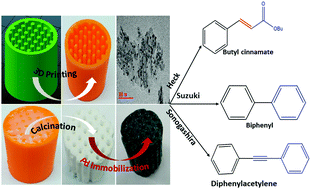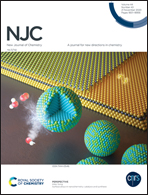Monolith catalyst design via 3D printing: a reusable support for modern palladium-catalyzed cross-coupling reactions†
Abstract
The use of an additive manufacturing procedure for the modification of catalytic structures is currently gaining popularity in the field of catalysis. Herein, we report the application of a commercially available 3D-printer for the rapid development of a reusable alumina monolith as a support in a heterogeneous system. Palladium nanoparticles (PdNps) were successfully immobilized on the prepared monolith using the deposition–precipitation method. The properties of the palladium incorporated monolith (Pd-MOT) were assessed via detailed characterization techniques. To quantitatively benchmark the performance of the prepared monolith catalyst (Pd-MOT), a powdered equivalent was prepared by crushing a fraction of Pd-MOT, which is denoted as Pd/Al2O3. Both catalysts were employed in the Mizoroki–Heck, Suzuki–Miyaura and copper-free Sonogashira–Hagihara cross-coupling reactions. The results show that Pd-MOT demonstrated enhanced catalytic activity compared to the Pd/Al2O3 catalyst in all the reactions investigated. The enhanced performance of Pd/MOT is attributed to its structural design. This helps to promote the compartmentalization of PdNps within the monolith structure, thus minimizing leaching, agglomeration, and catalyst loss. In addition to enhanced catalytic activity, the monolithic version (Pd-MOT) further demonstrates excellent stability and reusability.



 Please wait while we load your content...
Please wait while we load your content...